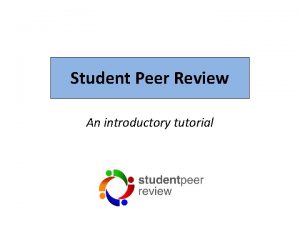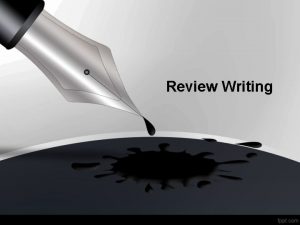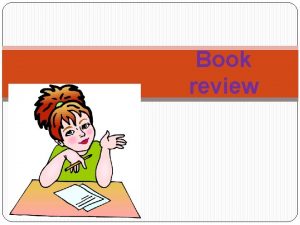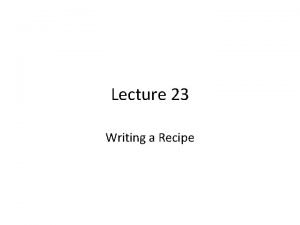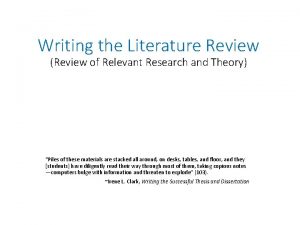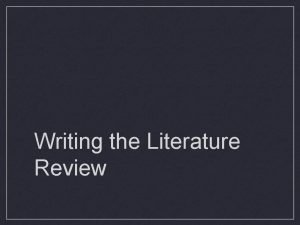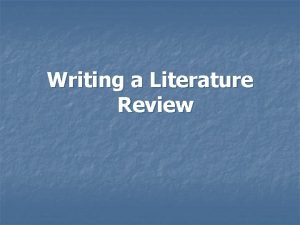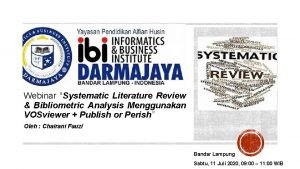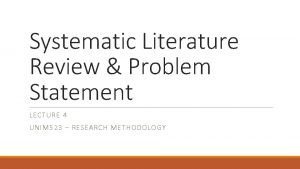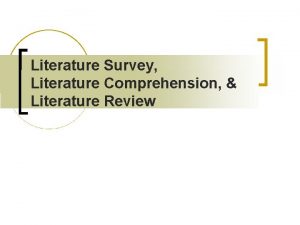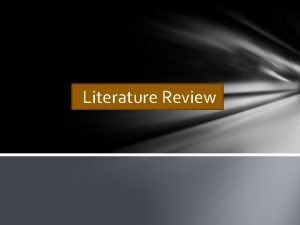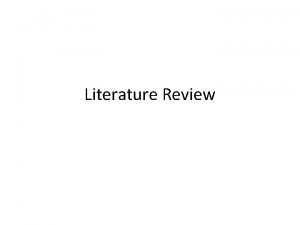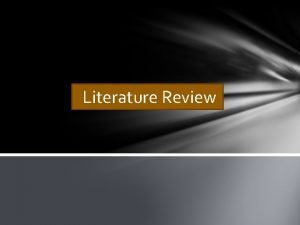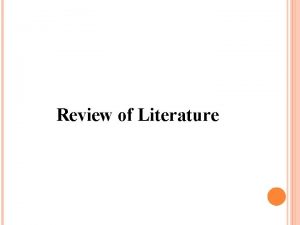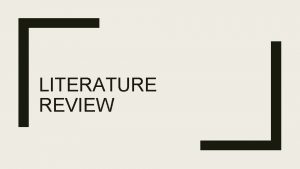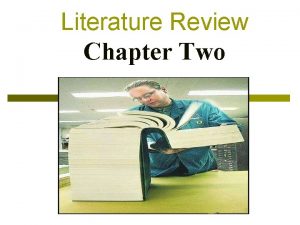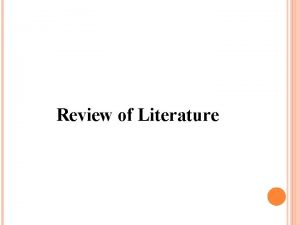How to Write a Literature Review A literature


















- Slides: 18

How to Write a Literature Review

• A literature review is a survey of scholarly sources on a specific topic. It provides an overview of current knowledge, allowing you to identify relevant theories, methods, and gaps in the existing research. • Conducting a literature review involves collecting, evaluating and analyzing publications (such as books and journal articles) that relate to your research question. There are five main steps in the process of writing a literature review:

• Review of literature is one of the most important steps in the research process. • It is an account of what is already known about a particular phenomenon. • The main purpose of literature review is to convey to the readers about the work already done & the knowledge & ideas that have been already established on a particular topic of research. • Literature review is a laborious task, but it is essential if the research process is to be successful.

Why write a literature review? • When you write a thesis, dissertation, or research paper, you will have to conduct a literature review to situate your research within existing knowledge. The literature review gives you a chance to: • Demonstrate your familiarity with the topic and scholarly context • Develop a theoretical framework and methodology for your research • Show your research addresses a gap or contributes to a debate

• Identification of a research problem & development or refinement of research questions. • Orientation to what is known & not known about an area of inquiry to ascertain what research can best contribute to knowledge. • Determination of any gaps or inconsistencies in a body of knowledge. • Determination of a need to replicate a prior study in different study settings or different samples or size or different study population.

• Description of the strengths & weaknesses of design/methods of inquiry & instruments used in earlier research work. • Development of hypothesis to be tested in a research study. • It also helps in development of research instruments. • It also provide the knowledge about the problems faced by the previous researchers’ while studying same topic.

Steps in writing Literature Review 1. 2. 3. 4. 5. Search for relevant literature Evaluate sources Identify themes, debates and gaps Outline the structure Write your literature review

Step 1: Search for relevant literature • Before you begin searching for literature, you need a clearly defined topic. • If you are writing the literature review section of a dissertation or research paper, you will search for literature related to your research problem and questions. • If you are writing a literature review as a stand-alone assignment, you will have to choose a focus and develop a central question to direct your search. Unlike a dissertation research question, this question has to be answerable without collecting original data. You should be able to answer it based only on a review of existing publications.

• Search for literature using keywords and citations • Start by creating a list of keywords related to your research topic and question. Some useful databases to search for journals and articles include: • • Your university’s library catalogue Google Scholar JSTOR EBSCO Project Muse (humanities and social sciences) Medline (life sciences and biomedicine) Econ. Lit (economics) Inspec (physics, engineering and computer science)

• Read the abstract to find out whether an article is relevant to your question. When you find a useful book or article, you can check the bibliography to find other relevant sources. • To identify the most important publications on your topic, take note of recurring citations. If the same authors, books or articles keep appearing in your reading, make sure to seek them out. • You can find out how many times an article has been cited on Google Scholar – a high citation count means the article has been influential in the field, and should certainly be included in your literature review.

Step 2: Evaluate and select sources • You probably won’t be able to read absolutely everything that has been written on the topic – you’ll have to evaluate which sources are most relevant to your questions. • For each publication, ask yourself: • What question or problem is the author addressing? • What are the key concepts and how are they defined? • What are the key theories, models and methods? Does the research use established frameworks or take an innovative approach? • What are the results and conclusions of the study? • How does the publication relate to other literature in the field? Does it confirm, add to, or challenge established knowledge? • How does the publication contribute to your understanding of the topic? What are its key insights and arguments? • What are the strengths and weaknesses of the research?

Step 3: Identify themes, debates, and gaps • To begin organizing your literature review’s argument and structure, you need to understand the connections and relationships between the sources you’ve read. Based on your reading and notes, you can look for: • Trends and patterns (in theory, method or results): do certain approaches become more or less popular over time? • Themes: what questions or concepts recur across the literature? • Debates, conflicts and contradictions: where do sources disagree? • Pivotal publications: are there any influential theories or studies that changed the direction of the field? • Gaps: what is missing from the literature? Are there weaknesses that need to be addressed?

Step 4: Outline your literature review’s structure • There are various approaches to organizing the body of a literature review. You should have a rough idea of your strategy before you start writing. • Depending on the length of your literature review, you can combine several of these strategies (for example, your overall structure might be thematic, but each theme is discussed chronologically).

cont. • • Chronological The simplest approach is to trace the development of the topic over time. However, if you choose this strategy, be careful to avoid simply listing and summarizing sources in order. • Try to analyze patterns, turning points and key debates that have shaped the direction of the field. Give your interpretation of how and why certain developments occurred. • • Thematic If you have found some recurring central themes, you can organize your literature review into subsections that address different aspects of the topic. • For example, if you are reviewing literature about inequalities in migrant health outcomes, key themes might include healthcare policy, language barriers, cultural attitudes, legal status, and economic access.

cont. • • Methodological If you draw your sources from different disciplines or fields that use a variety of research methods, you might want to compare the results and conclusions that emerge from different approaches. For example: • • Look at what results have emerged in qualitative versus quantitative research Discuss how the topic has been approached by empirical versus theoretical scholarship Divide the literature into sociological, historical, and cultural sources Theoretical A literature review is often the foundation for a theoretical framework. You can use it to discuss various theories, models, and definitions of key concepts. • • You might argue for the relevance of a specific theoretical approach, or combine various theoretical concepts to create a framework for your research.

Step 5: Write your literature review • Like any other academic text, your literature review should have an introduction, a main body, and a conclusion. What you include in each depends on the objective of your literature review. Introduction • The introduction should clearly establish the focus and purpose of the literature review.

Cont. Body • Depending on the length of your literature review, you might want to divide the body into subsections. You can use a subheading for each theme, time period, or methodological approach. • As you write, you can follow these tips: • Summarize and synthesize: give an overview of the main points of each source and combine them into a coherent whole • Analyze and interpret: don’t just paraphrase other researchers— add your own interpretations where possible, discussing the significance of findings in relation to the literature as a whole • Critically evaluate: mention the strengths and weaknesses of your sources • Write in well-structured paragraphs: use transitions and topic sentences to draw connections, comparisons and contrasts

Conclusion • In the conclusion, you should summarize the key findings you have taken from the literature and emphasize their significance.
 Chapter review motion part a vocabulary review answer key
Chapter review motion part a vocabulary review answer key Uncontrollable spending ap gov
Uncontrollable spending ap gov Nader amin-salehi
Nader amin-salehi Systematic review definition
Systematic review definition Narrative review vs systematic review
Narrative review vs systematic review How to write a peer review for college
How to write a peer review for college Whats a good review to write
Whats a good review to write How to write a film review
How to write a film review Describing photos in english
Describing photos in english Write a review of book you have recently read
Write a review of book you have recently read How to write a recipe review
How to write a recipe review Teknik mapping pada memori
Teknik mapping pada memori Literature review definition
Literature review definition Literature review
Literature review Order literature review
Order literature review Systematic literature review and bibliometric analysis
Systematic literature review and bibliometric analysis Literature review problem statement example
Literature review problem statement example Literature review gantt chart
Literature review gantt chart Scribbr
Scribbr





